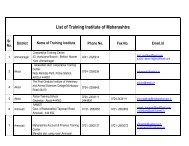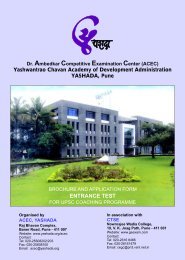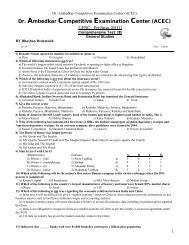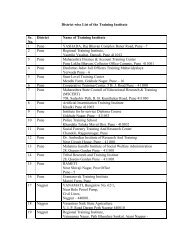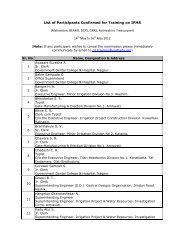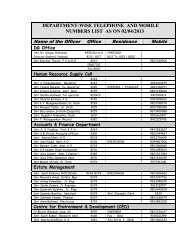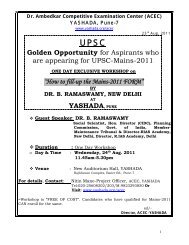Proceeding of the Agenda Setting Workshop at Shimla (pdf) - yashada
Proceeding of the Agenda Setting Workshop at Shimla (pdf) - yashada
Proceeding of the Agenda Setting Workshop at Shimla (pdf) - yashada
Create successful ePaper yourself
Turn your PDF publications into a flip-book with our unique Google optimized e-Paper software.
<strong>Proceeding</strong>s <strong>of</strong> <strong>the</strong> <strong>Workshop</strong> on Training Initi<strong>at</strong>ive under <strong>the</strong> DFID supportedprogramme on Capacity Building for Poverty Reduction(CBPR) held <strong>at</strong>Himachal Pradesh Institute for Public Administr<strong>at</strong>ion, <strong>Shimla</strong> on 22-23 rd June 06Prepared byDepartment <strong>of</strong> Personnel & TrainingOld JNU Campus, New Delhi
Appendix 1Directions suggested by <strong>the</strong> <strong>Workshop</strong> participantsThe intent <strong>of</strong> this workshop is to develop a training agenda with service-delivery as <strong>the</strong>central concept. A discussion paper (Annexure I) was circul<strong>at</strong>ed to all <strong>the</strong> participantsoutlining <strong>the</strong> broad parameters <strong>of</strong> <strong>the</strong> CBPR program and <strong>the</strong> framework under which <strong>the</strong>training initi<strong>at</strong>ive may be discussed. <strong>Workshop</strong> was for two days. The first day proceedingscovered <strong>the</strong> experiences <strong>of</strong> various ATIs and setting up <strong>of</strong> <strong>the</strong> basic agenda. The second daydeliber<strong>at</strong>ions included consolid<strong>at</strong>ing <strong>the</strong> lessons learnt from <strong>the</strong> first day and identify <strong>the</strong> keydirections for <strong>the</strong> training initi<strong>at</strong>ive under <strong>the</strong> CBPR program. The schedule for <strong>the</strong>workshop and <strong>the</strong> list <strong>of</strong> Participants is given as Annexure II and III respectively.Session 1: Opening Remarks<strong>Proceeding</strong>s on Day 1 (22 nd June 06)Shri Ajay Mittal, Director, HPIPA welcoming <strong>the</strong> workshop participants indic<strong>at</strong>ed th<strong>at</strong> it wasindeed a privilege to host <strong>the</strong> conference and thanked DOPT for having provided <strong>the</strong>opportunity. He fur<strong>the</strong>r indic<strong>at</strong>ed th<strong>at</strong> <strong>the</strong> issues to be discussed in <strong>the</strong> workshop were asrelevant to HPIPA and Himachal Pradesh as <strong>the</strong>y were to <strong>the</strong> rest <strong>of</strong> <strong>the</strong> country. He hopedth<strong>at</strong> this workshop would provided important inputs and would be considered as a majormilestone in <strong>the</strong> CBPR programShri Ajay Sawhney, Joint Secretary, DOPT thanked Director, HPIPA for <strong>the</strong> excellentarrangements. He remarked th<strong>at</strong> it was heartening to see a good represent<strong>at</strong>ion from <strong>the</strong>Administr<strong>at</strong>ive Training Institutes from all over <strong>the</strong> country and th<strong>at</strong> <strong>the</strong> deliber<strong>at</strong>ions willbenefit from <strong>the</strong> presence <strong>of</strong> experienced trainers from <strong>the</strong> particip<strong>at</strong>ing institutes in <strong>the</strong>workshop. He gave a brief overview <strong>of</strong> <strong>the</strong> CBPR program and underlined <strong>the</strong> fact th<strong>at</strong>effective delivery <strong>of</strong> public services is <strong>the</strong> key for poverty allevi<strong>at</strong>ion since poor spendconsiderable time, effort, and money for finding altern<strong>at</strong>ive to services which ought to beprovided by <strong>the</strong> government. The purpose <strong>of</strong> <strong>the</strong> workshop, Mr Sawhney indic<strong>at</strong>ed, was togener<strong>at</strong>e ideas th<strong>at</strong> would form <strong>the</strong> training agenda under <strong>the</strong> CBPR program. He alsorequested <strong>the</strong> workshop participants to take into account, during <strong>the</strong> deliber<strong>at</strong>ions, some <strong>of</strong><strong>the</strong> initi<strong>at</strong>ives taken under <strong>the</strong> UNDP program which included capacity building <strong>of</strong> <strong>the</strong> ATIsand intensive district training initi<strong>at</strong>ives.Session II: Program background and <strong>Agenda</strong> for <strong>the</strong> workshopShri D. Durga Prasad from Adam Smith Intern<strong>at</strong>ional, <strong>the</strong> Program ManagementConsultants for <strong>the</strong> CBPR program made a present<strong>at</strong>ion on <strong>the</strong> program background and<strong>the</strong> agenda for <strong>the</strong> workshop (Annexure IV). It was highlighted th<strong>at</strong> <strong>the</strong> basic premise <strong>of</strong><strong>the</strong> program is <strong>the</strong> recognition <strong>of</strong> <strong>the</strong> link between efficient and effective publicadministr<strong>at</strong>ion and poverty reduction. One <strong>of</strong> <strong>the</strong> main program initi<strong>at</strong>ives is <strong>the</strong>improvement <strong>of</strong> service delivery. It was st<strong>at</strong>ed th<strong>at</strong> <strong>the</strong> role <strong>of</strong> training under <strong>the</strong> broadobjective <strong>of</strong> <strong>the</strong> program derives from <strong>the</strong> fact th<strong>at</strong> quality and quantity <strong>of</strong> service delivery isclosely linked to <strong>the</strong> orient<strong>at</strong>ion <strong>of</strong> <strong>the</strong> personnel in <strong>the</strong> service delivery unit. Training wasprimarily to make <strong>the</strong> frontline personnel to be task ready. The agenda outlined for <strong>the</strong>workshop included: (i) Identifying main gaps/constraints in development andimplement<strong>at</strong>ion <strong>of</strong> a plan for training for service delivery which is scalable and replicableacross <strong>the</strong> country while be cost-effective and identify possible solutions/str<strong>at</strong>egies toovercome <strong>the</strong>se, (ii) An inventory <strong>of</strong> training tools and techniques th<strong>at</strong> need to be developedfor pervasive use based on experiences <strong>of</strong> <strong>the</strong> various ATIs under <strong>the</strong> UNDP and o<strong>the</strong>refforts, (iii) Identifying main components <strong>of</strong> a TNA exercise for service delivery training and- 1 -
Appendix 1Directions suggested by <strong>the</strong> <strong>Workshop</strong> participants(iv) Methods <strong>of</strong> replic<strong>at</strong>ing effective training interventions done in various st<strong>at</strong>es across <strong>the</strong>country.Summary <strong>of</strong> discussions and comments in Session II1. Shri Ajay Sawhney, Joint Secretary, DOPT while commenting on <strong>the</strong> agenda for <strong>the</strong>workshop highlighted <strong>the</strong> following aspects:i. St<strong>at</strong>e-<strong>of</strong>-<strong>the</strong>-art in TNA is well developed and generic enough to be deployedacross sectors with appropri<strong>at</strong>e customis<strong>at</strong>ion.ii.Training tools are available with ATIs. To <strong>the</strong> extent possible <strong>the</strong> available toolsshould be used for any training initi<strong>at</strong>ive developed under <strong>the</strong> program.He also suggested th<strong>at</strong>:iii.iv.The ownership <strong>of</strong> <strong>the</strong> line departments, which are <strong>the</strong> service providers, has tobe ensured for successfully initi<strong>at</strong>ing any training plan. Line Departments in St<strong>at</strong>eand Central governments will have to be taken on board.Any effort in piloting a training scheme developed/proposed under <strong>the</strong> CBPRprogram should be implemented through to its last step and an evalu<strong>at</strong>ion doneto assess its usefulness.2. Pr<strong>of</strong>. J. George, Chair, Faculty <strong>of</strong> Economics and Development Planning, HIPAcommented th<strong>at</strong>i. The human resource constraint faced by <strong>the</strong> ATIs is a factor th<strong>at</strong> should be keptin mind while designing any program.ii.iii.The ATIs have <strong>the</strong> experience and <strong>the</strong> expertise in conducting TNAsReplic<strong>at</strong>ing an existing training model(s) per se or specifying a universal trainingframework might not be functional. Customis<strong>at</strong>ion based on st<strong>at</strong>e specific issueswould be necessary.3. Mrs Mala Shrvastava, DG, Academy <strong>of</strong> Administr<strong>at</strong>ion, Bhopali. It is critical th<strong>at</strong> <strong>the</strong> training needs be discussed in <strong>the</strong> context <strong>of</strong> governancereforms th<strong>at</strong> are required. Ownership <strong>of</strong> existing poverty reduction program by<strong>the</strong> bureaucracy <strong>at</strong> <strong>the</strong> cutting edge is generally poor.ii.iii.iv.The authority <strong>of</strong> <strong>the</strong> Collector has diluted since <strong>the</strong> implement<strong>at</strong>ion <strong>of</strong> <strong>the</strong> 73rdand 74th amendment, resulting in no single authority <strong>at</strong> <strong>the</strong> district level.Training has to be discussed in <strong>the</strong> context <strong>of</strong> <strong>the</strong> changed ground realities.For <strong>the</strong> existing poverty allevi<strong>at</strong>ion programs <strong>the</strong>re is no assessment <strong>of</strong> <strong>the</strong>rel<strong>at</strong>ionship between program performance and family (beneficiary) wellbeing.No real monitoring mechanism in place. Probably department <strong>of</strong> economics andst<strong>at</strong>istics can be <strong>the</strong> agency for monitoring <strong>the</strong> programs on poverty allevi<strong>at</strong>ion.Adequ<strong>at</strong>e training may need to be imparted to <strong>the</strong> personnel <strong>of</strong> this department.Standards need to be set and an indic<strong>at</strong>or set developed.Are we concentr<strong>at</strong>ing only on rural poor? Majority <strong>of</strong> poverty in <strong>the</strong> comingyears is expected to be concentr<strong>at</strong>ed in <strong>the</strong> Urban areas.- 2 -
Appendix 1Directions suggested by <strong>the</strong> <strong>Workshop</strong> participants4. Shri Venketesan, Consultant, Yashada commented on <strong>the</strong> training needs assessmentcomponent <strong>of</strong> training agenda as follows:i. Although numerous methodologies are available for TNA wh<strong>at</strong> is required is acommon sense approach. Examples <strong>of</strong> well accepted TNA are those developedby DOPT and Planning Commission. Recently developed YASHADA approach<strong>of</strong> a 4- stage TNA is also very robust.ii.The learning from <strong>the</strong> TNA should influence <strong>the</strong> training methods and content.5. Dr A. Ghosh, Deputy Director, ATI, West Bengal highlighted <strong>the</strong> important <strong>of</strong>making <strong>the</strong> training agenda recognise <strong>the</strong> decentralised planning th<strong>at</strong> is gaining ground<strong>at</strong> <strong>the</strong> district level. Specifically he comments were as follows:i. The institution <strong>of</strong> <strong>the</strong> District Magistr<strong>at</strong>e has lost control on <strong>the</strong> LineDepartments and any training program proposed under this program should takecognizance <strong>of</strong> this fact.ii.iii.iv.Under <strong>the</strong> 11th five year plan it is envisaged th<strong>at</strong> all districts will prepare a districtplan. ATIs can provide training for prepar<strong>at</strong>ion <strong>of</strong> <strong>the</strong> district plans. In additionATIs can contribute through training for prepar<strong>at</strong>ion <strong>of</strong> <strong>the</strong> District HumanDevelopment Reports, District vision st<strong>at</strong>ements, District Infrastructure andPoverty indices etc..Ramachandran committee advoc<strong>at</strong>es local planning on <strong>the</strong> Kerela model. T<strong>of</strong>acilit<strong>at</strong>e local planning ATI can provide training for evidence based advocacy egthrough training and oper<strong>at</strong>ionalising <strong>the</strong> use <strong>of</strong> development inform<strong>at</strong>ions<strong>of</strong>tware (s<strong>of</strong>tware provided by UNICEF for monitoring MillenniumDevelopment Goals) <strong>at</strong> <strong>the</strong> district level, development <strong>of</strong> village maps etc..Training on PRA and PLA techniques is important.6. Shri Ajay Mittal, Director, HPIPA highlighted th<strong>at</strong> importance <strong>of</strong> engaging <strong>the</strong>executive in improving service delivery for <strong>the</strong> poor while streng<strong>the</strong>ning <strong>the</strong> serviceusers ability to ask for better services.i. Along with considering how training can influence supply side <strong>of</strong> servicedelivery, it is important to consider <strong>the</strong> demand side or good quality servicedelivery and training as an influencer for <strong>the</strong> same. It may be worthwhile toconsider enabling <strong>the</strong> poor to articul<strong>at</strong>e <strong>the</strong>ir demand for better services.ii.The role <strong>of</strong> executive in influencing <strong>the</strong> quality <strong>of</strong> service delivery is exemplifiedby <strong>the</strong> success <strong>of</strong> <strong>the</strong> Pulse Polio campaign. Training programmes for sensitising<strong>the</strong> executive <strong>at</strong> various levels <strong>of</strong> government could have a significant impact.Role <strong>of</strong> training may be considered in this light.7. Dr Ram Mohan, Faculty, Institute <strong>of</strong> Management in Government, Kerelai. Informed th<strong>at</strong> Kerala has adopted a service delivery policy. In 2002 <strong>the</strong>Government <strong>of</strong> Kerala had launched a st<strong>at</strong>e level programme called <strong>the</strong>Modernizing Government Programme. Under this programme sevendepartments: Revenue, police, health, civil supply, educ<strong>at</strong>ion, local bodies, andsecretari<strong>at</strong> were identified to be covered under <strong>the</strong> service delivery policy.- 3 -
Appendix 1Directions suggested by <strong>the</strong> <strong>Workshop</strong> participantsAccordingly, training modules for 22-27 level <strong>of</strong> <strong>of</strong>ficials were prepared. Politicalleadership was also brought into <strong>the</strong> ambit <strong>of</strong> <strong>the</strong> project.8. Shri D. Durga Prasad from Adam Smith Intern<strong>at</strong>ionali. Informed th<strong>at</strong> DARPG has already initi<strong>at</strong>ed a program for providing qualitymark (SEVOTTAM) to service delivering institutions in <strong>the</strong> government domain.BIS has already notified <strong>the</strong> generic standard. Institutionaliz<strong>at</strong>ion <strong>of</strong>SEVOTTAM will address some <strong>of</strong> <strong>the</strong> concerns raised.The discussions during this session clearly revealed th<strong>at</strong> significant capacity has alreadybeen built in <strong>the</strong> training system under various initi<strong>at</strong>ives launched earlier. The traininginiti<strong>at</strong>ive under <strong>the</strong> CBPR has a pl<strong>at</strong>form available to launch itself. It would be prudentand advisable to build on existing capabilities so as to ensure synergy.However, <strong>the</strong>re seem to be clear gaps in terms <strong>of</strong> incorpor<strong>at</strong>ing emerging changes in <strong>the</strong>government structure and processes <strong>at</strong> <strong>the</strong> district levels into <strong>the</strong> training agenda. Theimportance <strong>of</strong> engaging <strong>the</strong> executive in <strong>the</strong> various service delivery initi<strong>at</strong>ives is something which needs emphasis.The discussion provided insights into <strong>the</strong> emerging training agenda <strong>of</strong> all <strong>the</strong> levels <strong>of</strong>government.In <strong>the</strong> next set <strong>of</strong> sessions <strong>the</strong> workshop participants were introduced to <strong>the</strong> innov<strong>at</strong>iveexperiences and experiments in training initi<strong>at</strong>ed by ATIs in different st<strong>at</strong>es. YASHADA,ATI <strong>of</strong> Maharashtra presented its innov<strong>at</strong>ions and experiential learning across <strong>the</strong> trainingspectrum beginning with TNA and ending with training evalu<strong>at</strong>ion, Academy <strong>of</strong>Administr<strong>at</strong>ion, ATI, MP presented a comprehensive model for training <strong>of</strong> front-linepersonnel, <strong>the</strong> Tamil Nadu ATI presented a training model th<strong>at</strong> dealt with <strong>the</strong> life space <strong>of</strong>employees <strong>of</strong> <strong>the</strong> government and final present<strong>at</strong>ion by ATI, AP elabor<strong>at</strong>ed on a changemanagement driven training plan. Training in <strong>the</strong> AP model has been conceptualised as apart <strong>of</strong> a Government reform process. The vari<strong>at</strong>ion in approaches and concerns provided arich mosaic <strong>of</strong> training options.Session III: Present<strong>at</strong>ion on district intensive training project in S<strong>at</strong>ara District byYashadaMs Poonam Mehta, Assistant Pr<strong>of</strong>, Yashada along with Shri S Venk<strong>at</strong>esan, Consultant,Yashada made <strong>the</strong> present<strong>at</strong>ions. The content and structure (<strong>the</strong> full present<strong>at</strong>ion is inAnnexure V & VI) <strong>of</strong> <strong>the</strong> present<strong>at</strong>ion were as followsa. Introduction to YashadaA brief on <strong>the</strong> Institute including various training and research projects beingundertaken.- 4 -
Appendix 1Directions suggested by <strong>the</strong> <strong>Workshop</strong> participantsb. Film <strong>of</strong> district intensive training Project – JagrutiFilm was screened providing an overview <strong>of</strong> <strong>the</strong> district intensive training project(christened Jagriti-Awakening). The film provided <strong>the</strong> overview <strong>of</strong> <strong>the</strong> training contentand <strong>the</strong> process.c. Present<strong>at</strong>ion on JagrutiIt was outlined <strong>the</strong> building blocks <strong>of</strong> <strong>the</strong> Jagriti project include (i) Bottom upTraining- class III & IV grade employees trained from 10cadres, (ii) Tailor madetraining modules along with training guides, (iii) Various training tools used- CBT,puppets, Multi media stage show, street plays, audio songs, film clippings iv trainersdeveloped from within <strong>the</strong> cadre (iv) Self improvement modules like Yoga and stressmanagement included in <strong>the</strong> training program (v) Reading and reference m<strong>at</strong>erial foreach cadre (vi) Training comprised knowledge, skill, <strong>at</strong>titude, (vii) 360 degree TNAdone – comprising <strong>of</strong> both work space and life space, (viii) Political leadershipinvolved to motiv<strong>at</strong>e and legitimize <strong>the</strong> program.The achievements highlighted include: (i) Training <strong>of</strong> 10431 employees in 9 months,(ii) 13 Audio-visual Aids, (iii) 10 cadre based films, (iv) 11 Training modules for allcadres, (v) Bank <strong>of</strong> 120 expert trainers cre<strong>at</strong>ed (vi) Large training effort withoutcompromising on quality – <strong>at</strong> one point 3000 employees being trainedsimultaneously (vii) Most <strong>of</strong> <strong>the</strong> trainees got to <strong>at</strong>tend a training program first time in<strong>the</strong>ir working life.d. Impact assessmentThe present<strong>at</strong>ion detailed <strong>the</strong> findings from <strong>the</strong> impact assessment <strong>of</strong> <strong>the</strong> DistrictIntensive Training <strong>at</strong> S<strong>at</strong>ara. Present<strong>at</strong>ion included <strong>the</strong> (i) Methodology <strong>of</strong> assessment (ii)Findings (iii) Highlights (learning)• The findings include: (i) Improved performance due to training (ii) Objectives set byYASHADA achieved (iii) M<strong>at</strong>erial/Modules/Films can be used by o<strong>the</strong>r districts (iv)Trainers from voluntary agencies, NGOs, Institutes, retired and serving <strong>of</strong>ficers (v)Availability <strong>of</strong> willing Resource Persons (vi) Good Quality <strong>of</strong> training m<strong>at</strong>erial (vii)Cre<strong>at</strong>ive training methods used (viii) Adaptability & adoptability <strong>of</strong> resourcesgener<strong>at</strong>ed (ix) Quality <strong>of</strong> life <strong>of</strong> participants improved (x) Positive <strong>at</strong>titude (postraining) – specially <strong>of</strong> peons and drivers (xi) Yoga taught in <strong>the</strong> training stillcontinues to be practiced by majority <strong>of</strong> employees• The highlights (wh<strong>at</strong> worked) from <strong>the</strong> project include: (i) Simplified TNA study (ii)Core team to monitor <strong>the</strong> project (iii) Camp Approach (iv) One time approvals (v)Training Venues selected with care (vi) Residential training (vii) Innov<strong>at</strong>ive trainingmethodse. Suggestions for <strong>the</strong> training initi<strong>at</strong>ive under <strong>the</strong> CBPR ProgramFocus on vulnerable groups – (i) Women- Widows, single women, Child Labour, (ii)Socially and economically disadvantaged groups, (iii) People with disabilityHarbinger innov<strong>at</strong>ions to make governance more inclusive: (i) Concepts- Citizencharter, Gender budgeting, (ii) Tools- GS/Remote Sensing, PPA (particip<strong>at</strong>orypoverty assessment)- 5 -
Appendix 1Directions suggested by <strong>the</strong> <strong>Workshop</strong> participantsCommentsImplement<strong>at</strong>ion for training frontline service delivery personnel may include : (i)Mapping Out Departments,(ii)Identifying cadres having interface with <strong>the</strong> poor anddelivery <strong>of</strong> services, (iii) Identify deliverables, Identify areas <strong>of</strong> convergence amongdepartments, (iv) Identify basic schemes, budget heads, funds, (v) Identify areas <strong>of</strong>training for each cadre, (vi) Decentralize trainingPrerequisites for streng<strong>the</strong>ning training for improved Governance: (i) Increasingbudget provision is essential but not a sufficient condition- increasing accountability<strong>of</strong> service providers is important (ii) Simple home-based training programs important(iii) Replicable Low cost training – use <strong>of</strong> technology, distance learningCapacity building pyramid: (i) Policy makers: Visioning, planning, leadership (ii)Decision makers : Handholding and Mentoring (iii) Middle Management :Management tools and Innov<strong>at</strong>ions (iv) Cutting edge personnel: Skills and <strong>at</strong>titudetraining1. Shri TD Negi, Director, Urban Development, Government <strong>of</strong> Himachal Pradeshi. Training is important for program/project implement<strong>at</strong>ion personnel.ii. Money availability for training is very low.iii. Urban poverty will be critical in <strong>the</strong> future, this is going to increaseiv. Definition <strong>of</strong> poverty needs a re-look, depriv<strong>at</strong>ion based approach is requiredv. DOPT has to be <strong>the</strong> nodal agency and provide training packages and funds,vi. Rural and urban poverty are different and hence training str<strong>at</strong>egies might have to bedifferentvii. Urban poverty has to be defined and discussed in a gender sensitive manner.2. Shri Rakesh Kaushal, Director , Rural Development, Government <strong>of</strong> Himachal Pradeshi. Capacity building <strong>of</strong> beneficiaries is important so th<strong>at</strong> <strong>the</strong>y can demand services3. Shri Ajay Mittal, Director, HPIPAi. Top political functionaries should be sensitized on <strong>the</strong> link between service deliveryand poverty allevi<strong>at</strong>ion. It is critical th<strong>at</strong> political leadership is interested4. Dr. Ram Mohan, Faculty, Institute <strong>of</strong> Management in Government, Trivandrumi. Kerela, training <strong>of</strong> elected represent<strong>at</strong>ive in project management has been impartedSession IV: Present<strong>at</strong>ion on Capacity Building for Service DeliveryMrs Mala Srivastava, Additional Chief Secretary and Director General Academy <strong>of</strong>Administr<strong>at</strong>ion, Bhopal made <strong>the</strong> present<strong>at</strong>ion. The content <strong>of</strong> <strong>the</strong> present<strong>at</strong>ion (for detailedpresent<strong>at</strong>ion see Annexure VII) is as follows:i. Basic Premise: (i) Governance is everyone’s business (ii) Decentralized and Particip<strong>at</strong>oryPlanning is necessary (iii) Linkage between Government and Civil Society (iv)Continuous monitoring and feedback- 6 -
Appendix 1Directions suggested by <strong>the</strong> <strong>Workshop</strong> participantsii. Pedagogical Issues : (i) Cost effective and need based training (ii) appreci<strong>at</strong>ion for areaspecific issues (iii) bring training closer to workplace (iv) particip<strong>at</strong>ory learning (iv)cre<strong>at</strong>ion <strong>of</strong> a local training resource based – helps in broad basing training (v) Usingvariety <strong>of</strong> media and methods <strong>of</strong> training – in-situ, institutional, distance and e-learning(vi) Use s<strong>at</strong>ur<strong>at</strong>ion approach in place <strong>of</strong> extension approach.iii. Institutional Issues: (i) Develop and manage interface with Govt. Departments andTraining Institutions. (ii) establish linkages <strong>of</strong> training with career progression and cadremanagement, (iii) Cre<strong>at</strong>ing institutional mechanism, its role and loc<strong>at</strong>ion to providerequisite training (iv) str<strong>at</strong>egy to meet <strong>the</strong> training needs by way <strong>of</strong> design, developmentand oper<strong>at</strong>ionalis<strong>at</strong>ion <strong>of</strong> training packagesiv. Technical Issues: (i) Clarity <strong>of</strong> self <strong>at</strong> cutting edge- functional skills and <strong>at</strong>titudinalorient<strong>at</strong>ion towards service, quality and effectiveness, (ii) Linking self respect ands<strong>at</strong>isfaction with effective performance, (iii) Inculc<strong>at</strong>ing values – work is worship andrespect for citizen in democracy (iv) Mutual cooper<strong>at</strong>ion, coordin<strong>at</strong>ion and team workin inter and intra department level (v) Motiv<strong>at</strong>e for implementing various projects /plan(vi) Ascertain validity, reliability and au<strong>the</strong>nticity <strong>of</strong> base line d<strong>at</strong>a, (vii) Integr<strong>at</strong>ion <strong>of</strong>sectors in district plan.v. Shift in premises <strong>of</strong> training: (i) Supply driven to demand driven, (ii) Formal training informal training institutions to formal/informal in-situ training (iii) training institutions astraining providers to Training institutions as package developers and implementers (iv)Training for <strong>of</strong>ficers to training for all especially cutting edge employees (v) Class roomorient<strong>at</strong>ion to Simul<strong>at</strong>ion and field orient<strong>at</strong>ion (vi) Knowledge and skills to competencebuildingvi. Shift from traditional to system based trainingvii. Detailed sector-wise personnel were listed from <strong>the</strong> cutting edge <strong>of</strong> service delivery aspotential candid<strong>at</strong>es for training.viii. Detailed training needs for cutting edge employees and elected represent<strong>at</strong>ives <strong>of</strong> ULBsand PRIs were outlined. The c<strong>at</strong>egories included were: (i) Frontline employees <strong>of</strong>development departments (ii) Class III Government Employees (iii) Class IVGovernment employees (iv) Public Represent<strong>at</strong>ives in ULBs (v) Public Represent<strong>at</strong>ivesin PRIs. (Details are in Annexure VII)Session V: Present<strong>at</strong>ion on Intensive District Training Program <strong>at</strong> Theni TamilnaduShri S. Palaniappan, Programme Director and Training Coordin<strong>at</strong>or, Anna Institute <strong>of</strong>Management, Chennai made <strong>the</strong> present<strong>at</strong>ion. The content <strong>of</strong> <strong>the</strong> present<strong>at</strong>ion (for detailedpresent<strong>at</strong>ion see Annexure VIII) is as follows:a. Critical success factors:i. Some <strong>of</strong> <strong>the</strong> critical factors which facilit<strong>at</strong>ed <strong>the</strong> implement<strong>at</strong>ion and success <strong>of</strong> <strong>the</strong>training project included: (i) The support from <strong>the</strong> district collector was critical, (ii)Political commitment and support, (iii) ATI commitment to make <strong>the</strong> program asuccess (iv) Self improvement module incorpor<strong>at</strong>ed – nutritive value <strong>of</strong> food,exercises, sleeping p<strong>at</strong>terns etc. - was a huge success with <strong>the</strong> trainees (v) for TNAobserv<strong>at</strong>ion technique was used (vi) Addressed <strong>the</strong> cost <strong>of</strong> error- 7 -
Appendix 1Directions suggested by <strong>the</strong> <strong>Workshop</strong> participantsii. It was reported th<strong>at</strong> 5500 employees were trainedb. Suggestions for <strong>the</strong> training initi<strong>at</strong>ive under <strong>the</strong> CBPR Programi. Service delivery parameters should be set – may include Speed <strong>of</strong> Execution,Accuracy and Correctness , Behaviour, clarity in communic<strong>at</strong>ion /content/processesii. Cutting edge employees and <strong>the</strong>ir supervisor should be <strong>the</strong> target group.c. O<strong>the</strong>r suggestions for impacting favorably <strong>the</strong> poori. Suggested a Mentor development program- details in Annexure VIIIComments1. Mrs Mala Srivastava, Additional Chief Secretary and Director General Academy <strong>of</strong>Administr<strong>at</strong>ion, Bhopali. People particip<strong>at</strong>ion can sometime be scuttled locally despite a will <strong>at</strong> <strong>the</strong>Government level. E.g. Sometimes Gram Sabha meetings are held l<strong>at</strong>e so as toexclude particip<strong>at</strong>ion.ii. Suggested th<strong>at</strong> campaign like politicians do during election time might be a good ideafor informing people <strong>of</strong> <strong>the</strong>ir rights.2. Shri MP Sethi, Joint Director General, HRD Institute <strong>of</strong> Andhra Pradeshi. Training has to be demand driven.ii. Training must be anchored on outcomeiii. ATIs have to position from training delivery to service deliveryiv. Head <strong>of</strong> Department should be responsible for training. Collector should be <strong>the</strong>training commissionerv. ATI should focus on capacity building for delivery <strong>of</strong> services and not positions astraining deliveryvi. Cre<strong>at</strong>ion <strong>of</strong> a IC str<strong>at</strong>egy is importantSession VI: Present<strong>at</strong>ion on <strong>the</strong> initi<strong>at</strong>ives taken by Andhra Pradesh on capacitybuilding for Service DeliveryThe Andhra Pradesh Initi<strong>at</strong>ive is positioned as a process <strong>of</strong> capacity building <strong>of</strong> Linedepartments and not a program designed for delivery <strong>of</strong> training only (details in AnnexureIX). The building blocks include:a. Departmental training str<strong>at</strong>egy ( D5 E Approach)- Define training Requirements,Design appropri<strong>at</strong>e interventions, Develop training modules and trainers, Deliverwhich includes Pilot , Valid<strong>at</strong>e and Standardize, Decentralize training, Evalu<strong>at</strong>etrainingb. Capacity Building Str<strong>at</strong>egy (6 Is Approach): Initi<strong>at</strong>ion <strong>of</strong> reform process,Identific<strong>at</strong>ion <strong>of</strong> intervention leaders, Involvement - Buyin <strong>of</strong> <strong>the</strong> organiz<strong>at</strong>ion,Implement<strong>at</strong>ion <strong>of</strong> <strong>the</strong> intervention, Internaliz<strong>at</strong>ion <strong>of</strong> <strong>the</strong> intervention,Institutionaliz<strong>at</strong>ion <strong>of</strong> <strong>the</strong> intervention- 8 -
Appendix 1Directions suggested by <strong>the</strong> <strong>Workshop</strong> participantsc. Implement<strong>at</strong>ion <strong>of</strong> <strong>the</strong> capacity building str<strong>at</strong>egyi. Governing for results workshop- i. Participants are <strong>the</strong> change leaders identifiedfrom within <strong>the</strong> departments who have positive orient<strong>at</strong>ion to reforms/change. CoreGroup is formed which is to lead reforms from within <strong>the</strong> organiz<strong>at</strong>ion. Str<strong>at</strong>egicaction plan put in place.ii. Str<strong>at</strong>egic Performance Innov<strong>at</strong>ion Units: Each department has a SPIU which isto (i) Develop <strong>of</strong> sector- str<strong>at</strong>egy & reform plans, (ii) Performance managementsystem and improving delivery focus in polices & programme, (iii) Processreengineering,(iv) Document<strong>at</strong>ion <strong>of</strong> innov<strong>at</strong>ions, success- stories, (v) Changemanagement programme for implement<strong>at</strong>ion <strong>of</strong> Public Service Deliveryimprovement plans.iii. Collabor<strong>at</strong>ive approach: The Core group and SPIU is expected to take forward <strong>the</strong>reforms agenda within <strong>the</strong> form<strong>at</strong> prescribed under <strong>the</strong> 6 Is approach with assistancefro HRDI for capacity building and CGG (Centre for Good Governance) for crosscutting reforms issues.iv. Mapping <strong>of</strong> Service delivery requirement: This is done to understand <strong>the</strong> servicedelivery domain <strong>of</strong> a department and is a prerequisite for preparing <strong>the</strong> str<strong>at</strong>egicaction plan. This includes: (i)familiarize with important schemes/programs <strong>of</strong> <strong>the</strong>government , (ii) Constraints in service delivery , (iii) Share best practices successstories (iv) TNA (v) Explore possibilities <strong>of</strong> convergence (vi) Public perception <strong>of</strong>services including views form civil societyv. Role <strong>of</strong> HRDI: Role <strong>of</strong> a process consultant, which is much more involved thanbeing just a dispenser <strong>of</strong> training.Summary <strong>of</strong> <strong>the</strong> day’s discussion1. Pr<strong>of</strong> DP Mishra, Institute <strong>of</strong> Rural Management, Anand summarized <strong>the</strong> daysdeliber<strong>at</strong>ions as follows:i. The AP model is not a training program per se, it has a larger agenda forreforms.ii.iii.It should be understood th<strong>at</strong> capacity building is not directly for povertyreduction but for <strong>the</strong> services on which <strong>the</strong> poor are maximally dependent.Most <strong>of</strong> <strong>the</strong> intervention by <strong>the</strong> St<strong>at</strong>e is targeted for HHs below <strong>the</strong> poverty line,however not much is being done for HHs which slip below <strong>the</strong> poverty line dueto certain economic shocks which <strong>the</strong> HHs face. Thus while every year we areable to pull a number <strong>of</strong> HHs above <strong>the</strong> poverty line, new households keepslipping below <strong>the</strong> poverty line, thus <strong>the</strong> net magnitude <strong>of</strong> BPL families is higherthan wh<strong>at</strong> would have been if <strong>the</strong> slippages could be prevented. For example,one <strong>of</strong> <strong>the</strong> major economic shocks resulting in families slipping below <strong>the</strong>poverty line is unforeseen health expenses. A good quality <strong>of</strong> health care (bothpreventive and cur<strong>at</strong>ive) to <strong>the</strong> poor through <strong>the</strong> St<strong>at</strong>e health machinery wouldstem such slippages from taking place since it is much cheaper than <strong>the</strong> priv<strong>at</strong>esector health care. Training component <strong>of</strong> <strong>the</strong> CBPR program throughproviding training to cutting edge service delivery personnel would help stemslippages under <strong>the</strong> Poverty line.- 9 -
Appendix 1Directions suggested by <strong>the</strong> <strong>Workshop</strong> participantsiv.Inform<strong>at</strong>ion on <strong>the</strong> rights <strong>of</strong> <strong>the</strong> beneficiaries can be imparted through acampaign mode. This cre<strong>at</strong>es an expenditure pressure on <strong>the</strong> St<strong>at</strong>e. KarmayogiShivirs in Gujar<strong>at</strong> is such a model.v. It would be useful to design <strong>the</strong> training modules under <strong>the</strong> CBPR around <strong>the</strong>fulcrum <strong>of</strong> self- esteem and dignity <strong>of</strong> <strong>the</strong> service delivery personnel.2. Shri Ajay Sawhney, Joint Secretary, DOPTi. AP initi<strong>at</strong>ive provides models th<strong>at</strong> are useful for <strong>the</strong> CBPR training initi<strong>at</strong>ive andis also relevant much beyond CBPR program. Such an initi<strong>at</strong>ive can possibly findplace in <strong>the</strong> 11 th Five Year Plan proposal <strong>of</strong> <strong>the</strong> department. AP modelpresupposes a much larger initi<strong>at</strong>ive/agenda for n<strong>at</strong>ional and st<strong>at</strong>e institutions.ii.iii.A possible way forward is to improve upon and replic<strong>at</strong>e <strong>the</strong> S<strong>at</strong>ara and Thenimodels. These are first-<strong>of</strong>-<strong>the</strong>ir kind experiments in providing intensive trainingto service delivery personnel <strong>at</strong> <strong>the</strong> grass root level. We may take up selectedsectors <strong>at</strong> <strong>the</strong> district level and implement <strong>the</strong> intensive training model.In <strong>the</strong> background <strong>of</strong> <strong>the</strong> present<strong>at</strong>ions so far, <strong>the</strong> workshop should throw up aconcrete way forward.3. Mrs Mala Srivastava, Additional Chief Secretary and Director General Academy <strong>of</strong>Administr<strong>at</strong>ion, Bhopali. The unique focus <strong>of</strong> <strong>the</strong> AP Initi<strong>at</strong>ive was th<strong>at</strong> government departments owned<strong>the</strong> program. DOPT may try to replic<strong>at</strong>e a similar model involving <strong>the</strong> CentralMinistries.4. Shri MP Sethi, Joint Director General, HRD Institute <strong>of</strong> Andhra Pradeshi. Administr<strong>at</strong>ive reforms linkage with training might be considered under <strong>the</strong>training initi<strong>at</strong>ive.ii.iii.iv.The departments which have to be involved under <strong>the</strong> training initi<strong>at</strong>ive (CBPR)have to be carefully chosen so th<strong>at</strong> <strong>the</strong> linkage with poverty reduction ismaintained.Initi<strong>at</strong>ives for cross cutting areas which are not specific to any department haveto be taken up separ<strong>at</strong>elyTraining should have high reach – technology can help in increasing reach5. Shri Vineet Pandey, Director, DOPTi. There is a need to find out means for replic<strong>at</strong>ing <strong>the</strong> S<strong>at</strong>ara and Theni models fora larger n<strong>at</strong>ional roll out. There is a need to arrive <strong>at</strong> a common minimumprogram. Wh<strong>at</strong> is <strong>the</strong> road map is <strong>the</strong> question we have to answer. We need tochalk out a plan <strong>of</strong> action.ii.iii.Evalu<strong>at</strong>ion and monitoring so as to ascertain impact <strong>of</strong> training is important.We have to prioritize <strong>the</strong> sectors, in which we have to bring in training as anintervention under <strong>the</strong> CBPR- 10 -
Appendix 1Directions suggested by <strong>the</strong> <strong>Workshop</strong> participants6. Shri D. Durga Prasad from Adam Smith Intern<strong>at</strong>ionali. Training should not be champion drivenii.iii.Training comprises <strong>of</strong> knowledge, skills and <strong>at</strong>titudeThe talent is in picking up <strong>the</strong> core idea and multiplying <strong>the</strong> elements <strong>of</strong> <strong>the</strong>program.The present<strong>at</strong>ions and <strong>the</strong> deliber<strong>at</strong>ions <strong>the</strong>reon during <strong>the</strong> first day <strong>of</strong> <strong>the</strong> workshopenabled <strong>the</strong> workshop participants to appreci<strong>at</strong>e <strong>the</strong> magnitude <strong>of</strong> <strong>the</strong> training agenda andall its manifest<strong>at</strong>ions. The importance <strong>of</strong> improving <strong>the</strong> quality <strong>of</strong> service delivery also gothighlighted in various discussions during <strong>the</strong> day. From <strong>the</strong> shared experiences andendeavours <strong>of</strong> <strong>the</strong> various ATIs it was evident th<strong>at</strong> varied knowledge and experience isavailable in different st<strong>at</strong>es in <strong>the</strong> country in <strong>the</strong> training domain. The challenge is inconverting into pervasively usable training modules in <strong>the</strong> shortest possible time. In o<strong>the</strong>rwords, how do we replic<strong>at</strong>e and scale this knowledge in a reasonable period <strong>of</strong> time. TheAP experience on <strong>the</strong> o<strong>the</strong>r hand provoked <strong>the</strong> participants to reflect on <strong>the</strong> necessity toreview <strong>the</strong> training institutes and <strong>the</strong>ir role. In fact, <strong>the</strong> pervasive view was to understandhow <strong>the</strong> AP initi<strong>at</strong>ive can be used to fur<strong>the</strong>r <strong>the</strong> training agenda under <strong>the</strong> CBPR.Thereafter it was obvious th<strong>at</strong> <strong>the</strong> remaining dur<strong>at</strong>ion <strong>of</strong> <strong>the</strong> workshop be spent onaddressing <strong>the</strong>se thought provoking questions while keeping <strong>the</strong> various constraints andconcerns articul<strong>at</strong>ed during <strong>the</strong> day in mind.It was agreed th<strong>at</strong> <strong>the</strong> expertise available with <strong>the</strong> workshop participants would be used todeliber<strong>at</strong>e and seek answers to <strong>the</strong>se questions (see box above). In oper<strong>at</strong>ional terms threetasks were identified for three groups formed from out <strong>of</strong> <strong>the</strong> workshop participants. Thetasks assigned to <strong>the</strong> three groups are as follows:a. Group I: Identific<strong>at</strong>ion and prioritiz<strong>at</strong>ion <strong>of</strong> pro-poor sectors and services th<strong>at</strong> needtraining intervention in <strong>the</strong> immedi<strong>at</strong>e and <strong>the</strong> long term (require process reengineering).The group was also expected to give cost estim<strong>at</strong>es.b. Group II: Replicability <strong>of</strong> successful models under <strong>the</strong> intensive district training program- abstracting from <strong>the</strong> experiences.c. Group III: Identify aspects <strong>of</strong> <strong>the</strong> AP initi<strong>at</strong>ive, which can be applied in <strong>the</strong> context <strong>of</strong><strong>the</strong> training initi<strong>at</strong>ive under <strong>the</strong> CBPR program.- 11 -
Appendix 1Directions suggested by <strong>the</strong> <strong>Workshop</strong> participants<strong>Proceeding</strong>s <strong>of</strong> Day II (23rd June 2006)1. Shri D. Durga Prasad from Adam Smith Intern<strong>at</strong>ional summarized <strong>the</strong> deliber<strong>at</strong>ions s<strong>of</strong>ar in <strong>the</strong> workshopi. Training Needs Assessment: Choice between life space v/s workspace approaches.Need to find quick ways <strong>of</strong> doing <strong>the</strong> TNAii. Low cost and easy to deliver trainingiii. Cre<strong>at</strong>ing a repository <strong>of</strong> training approaches and best practicesiv. Reaching <strong>the</strong> three tiers <strong>of</strong> <strong>the</strong> organiz<strong>at</strong>ion: will it be possible to do in a pervasivebasisv. Any training program recommended should be possible for implement<strong>at</strong>ion in <strong>the</strong>next two years (life <strong>of</strong> <strong>the</strong> program)2. V. Radha, Deputy Director General, YASHADA indic<strong>at</strong>ed th<strong>at</strong>:i. It is important th<strong>at</strong> we are able to define <strong>the</strong> pre-conditions which need to befulfilled for replic<strong>at</strong>ing <strong>of</strong> a successful training model.ii. It should not be difficult to make a pan Indian model, since <strong>the</strong>re are manycommonalities across <strong>the</strong> districts <strong>of</strong> <strong>the</strong> country which include:Collector as an institution is commonMost <strong>of</strong> <strong>the</strong> programs on which poor are dependent are Central sponsoredschemes (eg. Reproductive and Child Health Program) and are broadly similar allacross <strong>the</strong> country.Same cadre does almost similar work across <strong>the</strong> St<strong>at</strong>es/districts.3. The working groups made <strong>the</strong> present<strong>at</strong>ions on three core elements identified from <strong>the</strong>deliber<strong>at</strong>ions on first day <strong>of</strong> <strong>the</strong> workshop3.1 Group I: Identific<strong>at</strong>ion <strong>of</strong> <strong>the</strong> tasks and sectors in <strong>the</strong> immedi<strong>at</strong>e and <strong>the</strong> long run.Estim<strong>at</strong>e <strong>the</strong> costs involved.The present<strong>at</strong>ion made by Group I is given in Annexure X. The main recommend<strong>at</strong>ions<strong>of</strong> <strong>the</strong> group included:i. The sectors which need to be included (i) Health and Family welfare, (ii), RevenueAdministr<strong>at</strong>ion, (iii) Municipal Administr<strong>at</strong>ion, (iv) Rural Development, (v)Agriculture, (vi) Agriculture, (vii) PDS, (viii) Educ<strong>at</strong>ion (Primary & Middle), (ix)Deppt <strong>of</strong> SC/ST Welfare, (x) Registr<strong>at</strong>ion (Cooper<strong>at</strong>ion)ii. Phase I: Piloting <strong>the</strong> intensive district training program in 4 districts to valid<strong>at</strong>e <strong>the</strong>model and standardize it. Phase I to be completed by March 2007.iii. Expected cost for Phase I – Rs 40 lakhs per district for approx 8000 training days.iv. Phase II : Larger rolloutv. Selection <strong>of</strong> district to be based on <strong>the</strong> Number <strong>of</strong> BPL HHs- 12 -
Appendix 1Directions suggested by <strong>the</strong> <strong>Workshop</strong> participantsComments:Police department should be includedThe departments identified has to be fur<strong>the</strong>r detailed into <strong>the</strong> cadres who are to beincluded in training program.Selection <strong>of</strong> districts should be on <strong>the</strong> basis <strong>of</strong> willingness and commitment forimplementing <strong>the</strong> training program. Buyin <strong>of</strong> <strong>the</strong> district administr<strong>at</strong>ion is critical. It wassuggested th<strong>at</strong> a mechanism may be developed wherein <strong>the</strong> districts can possibly bid forhosting <strong>the</strong> program.Ano<strong>the</strong>r criteria is inclusion <strong>of</strong> districts selected under <strong>the</strong> RSVY/NREGP3.2 Group II: Replicability <strong>of</strong> successful models under <strong>the</strong> intensive district trainingprogram - abstracting from <strong>the</strong> experiences.The present<strong>at</strong>ion made by Group II is given in Annexure XI. The mainrecommend<strong>at</strong>ion <strong>of</strong> <strong>the</strong> group included:• Involvement <strong>of</strong> district <strong>of</strong>ficials (client) during <strong>the</strong> design <strong>of</strong> <strong>the</strong> program. Demanddriven approach• Involvement <strong>of</strong> <strong>the</strong> department in TNA• Field testing <strong>of</strong> <strong>the</strong> modules developed for acceptance and usefulness• Making <strong>the</strong> training job-specific with a mix <strong>of</strong> K-S-A• Cre<strong>at</strong>ing a bank <strong>of</strong> Trainers from <strong>the</strong> dist line dept and using <strong>the</strong>m as resourcepersons. In S<strong>at</strong>ara 120 master trainers developed who can be used for impartingtraining under a similar program in o<strong>the</strong>r districts.• Various training tools used- CBT, puppets, Multi media stage show, street plays,audio songs, film clippings – ideally specific to each cadre• Use <strong>of</strong> various training methodologies and training media• Reading m<strong>at</strong>erial with useful inform<strong>at</strong>ion and many practical tips• Making <strong>the</strong> programme Residential as much as possible and finding suitable venue asper <strong>the</strong> requirement <strong>of</strong> <strong>the</strong> cadre. Eg In S<strong>at</strong>ara use <strong>of</strong> school buildings duringsummer vac<strong>at</strong>ions• Involvement <strong>of</strong> leadership and dedic<strong>at</strong>ion <strong>of</strong> <strong>the</strong> core implement<strong>at</strong>ion team. Coreteam should have a fixed tenure.• One time approvals help in implement<strong>at</strong>ion3.3 Group III: Identify aspects <strong>of</strong> <strong>the</strong> AP initi<strong>at</strong>ive, which can be applied in <strong>the</strong> context <strong>of</strong><strong>the</strong> training initi<strong>at</strong>ive under <strong>the</strong> CBPR program.The present<strong>at</strong>ion made by Group III is given in Annexure XII. The mainrecommend<strong>at</strong>ion <strong>of</strong> <strong>the</strong> group included:i. Priming <strong>the</strong> ATIs’ for training reforms. The newer role envisaged for <strong>the</strong> ATIsinclude: (i) Conventional trainer, (ii) Developer <strong>of</strong> trainer and resource person, (iii)- 13 -
Appendix 1Directions suggested by <strong>the</strong> <strong>Workshop</strong> participantsChange management and capacity building, (iv) Process consult<strong>at</strong>ion andcollabor<strong>at</strong>ion.ii. Training and capacity building for converging Administr<strong>at</strong>ive Reforms and TrainingReforms for efficient delivery <strong>of</strong> public services through training <strong>the</strong> cutting edge<strong>of</strong>ficials.To elabor<strong>at</strong>e on this issue Mr. MP Sethi, member <strong>of</strong> this group, presented ideasdeveloped <strong>at</strong> <strong>the</strong> HRDI for building capacity <strong>of</strong> <strong>the</strong> training institute.iii. Present<strong>at</strong>ion on leveraging on change as opportunity for transform<strong>at</strong>ion,growth & organis<strong>at</strong>ion development:Comments:Shri MP Sethi, Joint Director General, HRD Institute <strong>of</strong> Andhra Pradesh followedup <strong>the</strong> present<strong>at</strong>ion made by Group III by presenting <strong>the</strong> means <strong>of</strong> bringing inorganiz<strong>at</strong>ional change in <strong>the</strong> ATIs to position it as a process consultant, than just adispenser <strong>of</strong> training. The detail <strong>of</strong> <strong>the</strong> present<strong>at</strong>ion is given in Annexure XIII. Thesalient fe<strong>at</strong>ures highlighted for effecting this transform<strong>at</strong>ion include: (i) ExpandingCore-pr<strong>of</strong>ile <strong>of</strong> faculty, (ii) Programmes to be upgraded to ToT level (e.g. noprogram to be run by <strong>the</strong> ATI for more than 2 years, to be transferred to <strong>the</strong> TOTs),(iii) Post training Seminars / Design Reviews (training to be demand driven) , (iv)Programme Overviews – 3Rs (Requirement, R<strong>at</strong>ional, Relevance) , (v) System<strong>at</strong>icDesign <strong>of</strong> Programmes (Training as a str<strong>at</strong>egic tool in development, developinterface with Line departments), (vi) Programme Monitoring , (vii) ProgrammeDocument<strong>at</strong>ion and Module Development.1. Shri Vineet Pandey , Director, DOPTSuggested th<strong>at</strong> a Core Group be formed <strong>at</strong> HIPA, Gurgaon for examining <strong>the</strong>possibility <strong>of</strong> adapting <strong>the</strong> AP model for a pan India replic<strong>at</strong>ion under <strong>the</strong> XIth FiveYear Plan. The Core group would also be a technical resource to DOPT on <strong>the</strong>training initi<strong>at</strong>ive under <strong>the</strong> CBPR program.The group work and <strong>the</strong> deliber<strong>at</strong>ions th<strong>at</strong> followed <strong>the</strong>ir present<strong>at</strong>ions formed <strong>the</strong> basisfor identifying directions suggested by <strong>the</strong> workshop for <strong>the</strong> training and rel<strong>at</strong>ed aspectsunder <strong>the</strong> CBPR programme. It was discussed and decided th<strong>at</strong> <strong>the</strong>se directions wouldform <strong>the</strong> basis for developing an action plan for launching <strong>the</strong> training initi<strong>at</strong>ive.The main directions suggested by <strong>the</strong> <strong>Workshop</strong> participants are documented in Appendix 1- 14 -
Appendix 1Directions suggested by <strong>the</strong> <strong>Workshop</strong> participantsAppendix IDirection suggested by <strong>the</strong> <strong>Workshop</strong>Participants- 15 -
Appendix 1Directions suggested by <strong>the</strong> <strong>Workshop</strong> participantsAnnexure IDiscussion paper for <strong>the</strong> workshop- 16 -
Appendix 1Directions suggested by <strong>the</strong> <strong>Workshop</strong> participantsDiscussion Note for <strong>the</strong> <strong>Workshop</strong>OnTraining for Service Delivery- 17 -
Appendix 1Directions suggested by <strong>the</strong> <strong>Workshop</strong> participantsTraining for Capacity BuildingThe programme: Capacity Building for Poverty Reduction (CBPR)The Department <strong>of</strong> Administr<strong>at</strong>ive Reforms and Public Grievances (DARPG), Ministry <strong>of</strong>Personnel, <strong>of</strong> <strong>the</strong> Government <strong>of</strong> India is mand<strong>at</strong>ed to continuously undertakeadministr<strong>at</strong>ive reforms th<strong>at</strong> would make <strong>the</strong> public service delivery systems more citizenfriendly and in particular poor friendly. DFID with <strong>the</strong> objective <strong>of</strong> poverty reduction issupporting a capacity building programme by DARPG titled Capacity Building for PovertyReduction (CBPR) Programme.While poverty reduction is an end objective, it is not possible to directly work on povertyreduction without working on <strong>the</strong> intermedi<strong>at</strong>e variables th<strong>at</strong> affect it. The task <strong>of</strong> capacitybuilding can be taken up only for organis<strong>at</strong>ions and systems, which are clearly identifiable.Therefore, it is obvious th<strong>at</strong> <strong>the</strong> main focus <strong>of</strong> <strong>the</strong> effort for poverty reduction would be on<strong>the</strong> various organis<strong>at</strong>ions and systems, which directly or indirectly impact <strong>the</strong> conditions andlives <strong>of</strong> <strong>the</strong> poor. These systems do so through <strong>the</strong> various services <strong>the</strong>y deliver. It is largelyaccepted th<strong>at</strong> effective, efficient, and equitable delivery <strong>of</strong> basic services to <strong>the</strong> poor ispositively correl<strong>at</strong>ed to poverty reduction. It is, <strong>the</strong>refore, reasonable to assume th<strong>at</strong>competent and effective public service delivery systems, which fall under <strong>the</strong> realm <strong>of</strong> publicadministr<strong>at</strong>ion, are <strong>of</strong> critical importance for working towards poverty reduction.Consequently, it is worthwhile, and necessary, to build <strong>the</strong> capacity <strong>of</strong> public administr<strong>at</strong>ionorganis<strong>at</strong>ions and systems for impacting <strong>the</strong> poverty reduction effort <strong>of</strong> <strong>the</strong> country.The broadest definition <strong>of</strong> capacity building is <strong>the</strong> streng<strong>the</strong>ning <strong>of</strong> <strong>the</strong> institutional andorganis<strong>at</strong>ional arrangements <strong>of</strong> <strong>the</strong> domain concerned towards delivering services <strong>at</strong> <strong>the</strong>required standards. Such a broad definition would cover <strong>the</strong> various aspects <strong>of</strong> governance <strong>at</strong><strong>the</strong> central, st<strong>at</strong>e and local level (district/urban centre), <strong>the</strong> capabilities <strong>of</strong> variousorganis<strong>at</strong>ions th<strong>at</strong> provide services to <strong>the</strong> citizens (clients), and <strong>the</strong> knowledge skills and<strong>at</strong>titudes <strong>of</strong> <strong>the</strong> service-providing civil servant or pr<strong>of</strong>essional <strong>at</strong> each organis<strong>at</strong>ion. Theprocess <strong>of</strong> streng<strong>the</strong>ning would encompass each <strong>of</strong> <strong>the</strong>se.The capacity building for poverty reduction programme seeks to address issues pertaining to<strong>the</strong> institutional, organis<strong>at</strong>ional and individual aspects <strong>of</strong> service delivery. Different initi<strong>at</strong>iveshave been conceptualised to <strong>at</strong>tend to areas <strong>of</strong> concern in each <strong>of</strong> <strong>the</strong>se arenas. Thedepartment <strong>of</strong> Administr<strong>at</strong>ive reforms and public grievances (DARPG) has taken up <strong>the</strong> task<strong>of</strong> managing and monitoring <strong>the</strong> institutional and organis<strong>at</strong>ion rel<strong>at</strong>ed initi<strong>at</strong>ives, <strong>the</strong>department <strong>of</strong> personnel and training has taken up <strong>the</strong> task <strong>of</strong> leading <strong>the</strong> training rel<strong>at</strong>ediniti<strong>at</strong>ives <strong>at</strong> <strong>the</strong> individual level.Training as an Initi<strong>at</strong>iveA very important aspect <strong>of</strong>, and almost central to, any capacity building effort is<strong>the</strong> development <strong>of</strong> human resources. Even with <strong>the</strong> increasing spread <strong>of</strong>Inform<strong>at</strong>ion technology in delivery <strong>of</strong> services—whe<strong>the</strong>r by <strong>the</strong> government or <strong>the</strong>market—<strong>the</strong> centrality <strong>of</strong> human interface cannot be undermined. Therefore,effective and poor-friendly service delivery <strong>at</strong> various levels <strong>of</strong> government- 18 -
Appendix 1Directions suggested by <strong>the</strong> <strong>Workshop</strong> participantsacross <strong>the</strong> country would be significantly dependent on <strong>the</strong> quality <strong>of</strong> <strong>the</strong> peopleacross <strong>the</strong> service delivery chain.Civil servants or pr<strong>of</strong>essionals, depending on <strong>the</strong> n<strong>at</strong>ure <strong>of</strong> service, render frontline services. It is obvious th<strong>at</strong> <strong>the</strong> quality <strong>of</strong> service is primarily dependent on <strong>the</strong>knowledge, skills, and <strong>at</strong>titudes (KSA) <strong>of</strong> <strong>the</strong> personnel <strong>at</strong> <strong>the</strong> front-line. Althoughorganis<strong>at</strong>ional streng<strong>the</strong>ning, user feedback, and o<strong>the</strong>r user or citizen drivenpressures would have an effect on <strong>the</strong> performance <strong>of</strong> <strong>the</strong> service deliveryorganis<strong>at</strong>ions, <strong>the</strong> final impact would be as good as <strong>the</strong> competence andorient<strong>at</strong>ion <strong>of</strong> <strong>the</strong> personnel <strong>at</strong> <strong>the</strong> delivery point. This is <strong>the</strong> person who <strong>the</strong>citizen as user would be interacting regularly or whenever <strong>the</strong>re is a need. Theknowledge and skill levels, orient<strong>at</strong>ion, and motiv<strong>at</strong>ion <strong>of</strong> this person are <strong>of</strong>critical importance in <strong>the</strong> service delivery chain. While incentives are usually usedfor keeping <strong>the</strong> motiv<strong>at</strong>ion levels high, orient<strong>at</strong>ion and knowledge levels aremanaged through appropri<strong>at</strong>e training interventions.Therefore, <strong>the</strong> CBPR programme has identified training and rel<strong>at</strong>ed interventionsas a key input to capacity building efforts th<strong>at</strong> need to be undertaken forachieving <strong>the</strong> desirable outcomes <strong>of</strong> <strong>the</strong> programme. It is expected th<strong>at</strong> over <strong>the</strong>next three years or so various actions are initi<strong>at</strong>ed th<strong>at</strong> would provide a basket <strong>of</strong>relevant approaches, intervention tools, and techniques th<strong>at</strong> would helpstreng<strong>the</strong>n <strong>the</strong> training systems and processes <strong>of</strong> governments in <strong>the</strong> country.The main conceptAt <strong>the</strong> front-line levels <strong>of</strong> <strong>the</strong> civil service <strong>the</strong> incidence <strong>of</strong> training is significantlylow as acknowledged in <strong>the</strong> documents submitted by different committees on thism<strong>at</strong>ter. The N<strong>at</strong>ional Training Policy 1999 also acknowledges this in its vision <strong>of</strong>“training for all”. It says th<strong>at</strong> particularly <strong>at</strong> <strong>the</strong> front-line level <strong>of</strong> <strong>the</strong> civil servicesystem concerted efforts have to be made to equip <strong>the</strong>se functionaries to bemore responsive to citizens and <strong>the</strong> poor in particular.Many constraints have been identified in implementing <strong>the</strong> training policy.Training infrastructure, trainers, and training m<strong>at</strong>erial are some <strong>of</strong> <strong>the</strong> importantconstraints already identified. It is also acknowledged th<strong>at</strong> <strong>the</strong>re is no formaltraining objective set <strong>at</strong> any level <strong>of</strong> <strong>the</strong> government for <strong>the</strong> lower level civilservants. Training is not an integral part <strong>of</strong> <strong>the</strong> human resource managementsystem <strong>of</strong> various levels <strong>of</strong> government in <strong>the</strong> usual course <strong>of</strong> functioning. Theneed for training has become more pronounced in <strong>the</strong> present context <strong>of</strong> changein governance and role <strong>of</strong> governments. Need for a thorough and comprehensivereview <strong>of</strong> Human resources in general and training in particular has beenrecognised by <strong>the</strong> GoI in <strong>the</strong> guidelines appended to <strong>the</strong> N<strong>at</strong>ional Training Policy,1999.Services delivered by government agencies are more in <strong>the</strong> n<strong>at</strong>ure <strong>of</strong> anadministr<strong>at</strong>ive task. The beneficiaries experience <strong>the</strong> service as a favour(p<strong>at</strong>ronising behaviour <strong>of</strong> <strong>the</strong> service-provider) received and are in most casesobliged for having been recipients <strong>of</strong> <strong>the</strong> service. Although <strong>the</strong>re is realis<strong>at</strong>ionth<strong>at</strong> this has to change in <strong>the</strong> emerging globalis<strong>at</strong>ion scenario and demandingpublics, <strong>the</strong> oper<strong>at</strong>ionalis<strong>at</strong>ion <strong>of</strong> this change is not as pervasive as it should be.Public service delivery units are yet to appreci<strong>at</strong>e <strong>the</strong>ir role as one <strong>of</strong> service-- 19 -
Appendix 1Directions suggested by <strong>the</strong> <strong>Workshop</strong> participantsprovider ra<strong>the</strong>r than an administr<strong>at</strong>ive structure for distributing public service.This point has been highlighted by <strong>the</strong> Prime Minister in his inaugural speech <strong>at</strong><strong>the</strong> Civil Services day function 0n <strong>the</strong> 21 st <strong>of</strong> April 2006. To quote:“Historically, governments have viewed <strong>the</strong>mselves as administr<strong>at</strong>ors <strong>of</strong> publicdelivery systems. They have viewed citizens as outside beneficiaries <strong>of</strong>governmental action. Citizens were expected to accept wh<strong>at</strong>ever was provided,with little choice on <strong>of</strong>fer. This situ<strong>at</strong>ion is changing everywhere. Citizens areexpecting good service from Governments as a m<strong>at</strong>ter <strong>of</strong> right. Governments areexpected to deliver efficient public services or facilit<strong>at</strong>e priv<strong>at</strong>is<strong>at</strong>ion.Effectiveness and efficiency <strong>of</strong> public service delivery is increasingly beingdemanded as a basic right <strong>of</strong> <strong>the</strong> citizen. Government is expected to be a serviceproviderra<strong>the</strong>r than a mere administr<strong>at</strong>or <strong>of</strong> a public service delivery system. Thischange in orient<strong>at</strong>ion is <strong>the</strong> [third] key challenge facing <strong>the</strong> governments <strong>of</strong> thisday”.This is a paradigm shift in terms <strong>of</strong> government delivery systems. It would requirelarge scale change in many aspects <strong>of</strong> administr<strong>at</strong>ive systems and processes.But, a major concomitant change would have to be in <strong>the</strong> people who manageand deliver <strong>the</strong> services meant for <strong>the</strong> citizens in particular for <strong>the</strong> poor. Much <strong>of</strong><strong>the</strong> change would be perceived only if <strong>the</strong> civil servants assigned <strong>the</strong> task <strong>of</strong>service delivery perceive <strong>the</strong>mselves as service providers ra<strong>the</strong>r than mereadministr<strong>at</strong>ors. The challenge <strong>of</strong> training is in playing an important role in bringingabout this change.The training agenda <strong>of</strong> <strong>the</strong> governments in India is a difficult task. A number <strong>of</strong>issues have to be addressed and solutions for each <strong>of</strong> <strong>the</strong>m identified. The keyconcerns are:• The large number <strong>of</strong> people to be trained across levels. The number <strong>of</strong>people employed in <strong>the</strong> all <strong>the</strong> Central, st<strong>at</strong>e and local levels <strong>of</strong> governmentsis, indeed, large. Even if only those people who deal directly with citizens inaddressing <strong>the</strong>ir basic service requirements are taken into account almost75% <strong>of</strong> <strong>the</strong> total employees have to be trained.• The limited resources available with st<strong>at</strong>e and local level governments fortraining rel<strong>at</strong>ed activities.• The wide variety <strong>of</strong> services th<strong>at</strong> have to be trained for.The challenge for setting a training agenda is in finding low cost solutions th<strong>at</strong>are scalable while retaining <strong>the</strong>ir robustness.Efforts thus farOne <strong>of</strong> <strong>the</strong> main initi<strong>at</strong>ives in <strong>the</strong> direction <strong>of</strong> capacity building through traininghas been <strong>the</strong> UNDP funded “Streng<strong>the</strong>ning <strong>of</strong> <strong>the</strong> ATIs in India”. This programmeundertaken around 2001 included:1. Identific<strong>at</strong>ion <strong>of</strong> training needs <strong>of</strong> various employee c<strong>at</strong>egories.2. Development <strong>of</strong> training modules, <strong>of</strong> trainers, training techniques.3. Development specific capabilities in distance learning methodologies.- 20 -
Appendix 1Directions suggested by <strong>the</strong> <strong>Workshop</strong> participants4. Streng<strong>the</strong>ning <strong>of</strong> infrastructure <strong>of</strong> ATIs—computers, web-site, andlibraries.<strong>Setting</strong> up a Centre for Public policy was also an initi<strong>at</strong>ive under <strong>the</strong> UNDPproject to specifically fill <strong>the</strong> gap in <strong>the</strong> availability <strong>of</strong> high quality public policyacademic training in <strong>the</strong> country.The DoPT, which has been spearheading this effort, has also helped in trainingdistrict level functionaries in specific districts in seven st<strong>at</strong>es as a part <strong>of</strong> <strong>the</strong>UNDP initi<strong>at</strong>ive.Possible future actionsWhile significant work has been initi<strong>at</strong>ed and done in <strong>the</strong> area <strong>of</strong> streng<strong>the</strong>ning <strong>of</strong>training delivery systems as indic<strong>at</strong>ed above, <strong>the</strong>re appear to be gaps in <strong>the</strong>systems and process aspects <strong>of</strong> training. Not many projects rel<strong>at</strong>ed to enhancingservice delivery orient<strong>at</strong>ion have been initi<strong>at</strong>ed in <strong>the</strong> system.For streng<strong>the</strong>ning any training system it is essential to develop a clear trainingand development plan. Any training and development plan has <strong>the</strong> followingcomponents:• Clear Training Needs Assessment: this establishes <strong>the</strong> scale and scope <strong>of</strong>training.• Functional and adequ<strong>at</strong>e Training infrastructure: this ensures <strong>the</strong>feasibility <strong>of</strong> training• Availability or development <strong>of</strong> training m<strong>at</strong>erial and pedagogical tools: Thisprovides <strong>the</strong> basic content and process <strong>of</strong> training• Availability or development <strong>of</strong> rigorous training effectiveness evalu<strong>at</strong>iontools: this provides <strong>the</strong> feedback for <strong>the</strong> training system and helps inimproving <strong>the</strong> training delivery and ensures optimal utilis<strong>at</strong>ion <strong>of</strong>resources.With <strong>the</strong> increasing use <strong>of</strong> Inform<strong>at</strong>ion Technology (IT), <strong>the</strong> training deliverysystem can see dram<strong>at</strong>ic change over <strong>the</strong> next few years as <strong>the</strong> penetr<strong>at</strong>ion <strong>of</strong>computers and internet increases in <strong>the</strong> Government. The range <strong>of</strong> opportunitiesavailable for training using IT rel<strong>at</strong>ed tools is tremendous. The scope <strong>of</strong> low costdistance learning can be enlarged on a scale considered impossible hi<strong>the</strong>rto. Forexample, by using anim<strong>at</strong>ions and walk-through present<strong>at</strong>ions <strong>the</strong> front-line staffin public service providing entities can be sensitised to <strong>the</strong> best practices inservice delivery behaviour too. Use <strong>of</strong> IT in knowledge enhancement issomething which requires no introduction. The main challenge in using IT is in<strong>the</strong> development <strong>of</strong> appropri<strong>at</strong>e and easy-to-use s<strong>of</strong>tware for dissemin<strong>at</strong>ion to adispar<strong>at</strong>e set <strong>of</strong> users.The training agenda becomes so much more complex if <strong>the</strong> purpose <strong>of</strong> training isto enhance service-delivery as a competence needs to be developed acrosslevels <strong>of</strong> government and <strong>the</strong> bureaucracy. While service orient<strong>at</strong>ion rel<strong>at</strong>edtraining is available in <strong>the</strong> context <strong>of</strong> <strong>the</strong> players in various markets, <strong>the</strong>re is littleor no effort in this direction for citizen rel<strong>at</strong>ed public services. Wh<strong>at</strong>, how, andwhy <strong>of</strong> service delivery are yet to find a place <strong>of</strong> importance in <strong>the</strong> vast canvas <strong>of</strong>public service delivery systems in India. Even in <strong>the</strong> OECD context public service- 21 -
Appendix 1Directions suggested by <strong>the</strong> <strong>Workshop</strong> participantsdelivery systems have been reviewed and revamped for <strong>the</strong>ir service orient<strong>at</strong>iononly during <strong>the</strong> last decade or so. Reorienting <strong>the</strong> entire bureaucracy towardscitizen-centred service delivery reorient<strong>at</strong>ion is an imper<strong>at</strong>ive, albeit a large anddemanding task. Accordingly, cre<strong>at</strong>ing training tools, techniques, andpedagogical innov<strong>at</strong>ions, which provide low-cost solutions on a large scale,should be <strong>the</strong> objective <strong>of</strong> <strong>the</strong> training system.The training initi<strong>at</strong>ives should <strong>the</strong>refore seek to address <strong>the</strong> following aspects:• Develop a training agenda with service-delivery as <strong>the</strong> central concept.• All <strong>the</strong> techniques and training m<strong>at</strong>erial would need to be, accordingly,centred on issues <strong>of</strong> service delivery.• Develop a TNA methodology which can be used on a large scale, and in acost-effective manner. The tools should be simple enough to be used for selfassessmentby any service delivery unit.• Develop Training evalu<strong>at</strong>ion tools th<strong>at</strong> can pervasively used <strong>at</strong> various levels<strong>of</strong> service delivery units with least amount <strong>of</strong> external help and intervention.Under <strong>the</strong> CBPR programme <strong>the</strong>re are o<strong>the</strong>r initi<strong>at</strong>ives being launched forimproving service delivery for <strong>the</strong> poor. These initi<strong>at</strong>ives are <strong>at</strong> <strong>the</strong> organis<strong>at</strong>ionaland institutional level <strong>of</strong> change. It is obvious th<strong>at</strong> <strong>the</strong> studies undertaken onaccount <strong>of</strong> <strong>the</strong>se initi<strong>at</strong>ives would also reveal gaps training requirements <strong>of</strong> <strong>the</strong>organis<strong>at</strong>ions under review. As a result some more initi<strong>at</strong>ives would have to beconceptualised and launched once <strong>the</strong>se studies are over. It would bereasonable to expect th<strong>at</strong> <strong>the</strong>se studies are more likely to suggest trainingcontent rel<strong>at</strong>ed aspects ra<strong>the</strong>r than <strong>the</strong> training process and system rel<strong>at</strong>edaspects discussed in <strong>the</strong> earlier parts <strong>of</strong> this note. Hence, <strong>the</strong> output <strong>of</strong> <strong>the</strong> o<strong>the</strong>riniti<strong>at</strong>ives would complement <strong>the</strong> efforts being suggested above ra<strong>the</strong>r thansupplant <strong>the</strong>m.<strong>Workshop</strong> ObjectiveThe primary task would be set <strong>the</strong> agenda for training with service-delivery as <strong>the</strong>central concept. It would be necessary to understand <strong>the</strong> kind <strong>of</strong> training capacityth<strong>at</strong> needs to be developed or cre<strong>at</strong>ed in <strong>the</strong> country for ensuring th<strong>at</strong> th<strong>at</strong> <strong>the</strong>civil service <strong>of</strong>ficials <strong>at</strong> all levels <strong>of</strong> government and hierarchies are able toappreci<strong>at</strong>e <strong>the</strong> importance <strong>of</strong> service delivery. It is <strong>the</strong>refore expected th<strong>at</strong> <strong>the</strong>participants in this workshop would help <strong>the</strong> DoPT set an agenda for training civilservants in various aspects <strong>of</strong> service delivery.Specifically, <strong>the</strong> workshop should help in identifying and elabor<strong>at</strong>ing on <strong>the</strong>various components <strong>of</strong> training th<strong>at</strong> need to be streng<strong>the</strong>ned in <strong>the</strong> Indiancontext. Mainly <strong>the</strong> workshop participants would deb<strong>at</strong>e on:• The various types <strong>of</strong> front-line delivery personnel and <strong>the</strong>ir roles in servicedelivery.• The critical <strong>at</strong>tributes th<strong>at</strong> any public service provider has to possess toensure th<strong>at</strong> service-delivery is appropri<strong>at</strong>e and adequ<strong>at</strong>e.• The role th<strong>at</strong> training can play in developing such <strong>at</strong>tributes in civil servants,<strong>at</strong> various levels, responsible for delivery service to <strong>the</strong> poorer citizens <strong>of</strong> <strong>the</strong>country.- 22 -
Appendix 1Directions suggested by <strong>the</strong> <strong>Workshop</strong> participants• The manner in which <strong>the</strong> different components <strong>of</strong> training have to becoordin<strong>at</strong>ed so th<strong>at</strong> Training effectiveness is ensured• Deline<strong>at</strong>ing <strong>the</strong> scope and <strong>the</strong> scale <strong>of</strong> each training component in <strong>the</strong> context<strong>of</strong> service-delivery rel<strong>at</strong>ed training for civil servants <strong>at</strong> <strong>the</strong> st<strong>at</strong>e and local selfgovernmentlevels.• Specifically identifying those pedagogical tools and training delivery methodsth<strong>at</strong> would be appropri<strong>at</strong>e for low-cost delivery and on a large scale th<strong>at</strong> <strong>the</strong>various governments would require.Following <strong>the</strong> deliber<strong>at</strong>ions in <strong>the</strong> workshop, it is expected th<strong>at</strong> <strong>the</strong> followingoutputs would be obtained:• An inventory <strong>of</strong> training components th<strong>at</strong> needs to be put in place whichwould be essential to train civil servants for enhancing <strong>the</strong> service deliveryorient<strong>at</strong>ion.• A working concept <strong>of</strong> <strong>the</strong> pedagogical tools and techniques th<strong>at</strong> would berequired for training effectiveness• List <strong>of</strong> critical actions th<strong>at</strong> need to be initi<strong>at</strong>ed to ensure th<strong>at</strong> <strong>the</strong> emergentagenda is implemented.While <strong>the</strong> agenda for <strong>the</strong> workshop does include <strong>the</strong> concerns outlined above, itis clearly appreci<strong>at</strong>ed th<strong>at</strong> o<strong>the</strong>r concerns and options would emerge in <strong>the</strong>course <strong>of</strong> <strong>the</strong> workshop deliber<strong>at</strong>ions. The issues and concerns articul<strong>at</strong>ed in thisnote are expected to form <strong>the</strong> basis for discussion in <strong>the</strong> workshop; <strong>the</strong>y wouldact as constraints to <strong>the</strong> deb<strong>at</strong>e.- 23 -
Appendix 1Directions suggested by <strong>the</strong> <strong>Workshop</strong> participantsAnnexure IISchedule <strong>of</strong> <strong>the</strong> <strong>Workshop</strong>- 24 -
Appendix 1Directions suggested by <strong>the</strong> <strong>Workshop</strong> participantsSchedule <strong>of</strong> <strong>the</strong> two day workshop <strong>of</strong> ATIs on training initi<strong>at</strong>ive under <strong>the</strong>DFID supported programme on “Capacity Building for Poverty Reduction”to be held <strong>at</strong> HPIPA <strong>Shimla</strong> during 22-23 June 2006Venue: Seminar Hall, Kailash Guest House,HPIPA, <strong>Shimla</strong>22 nd June 200610.00 hrs Registr<strong>at</strong>ion10.30 hrs Welcome address by Director, HPIPA <strong>Shimla</strong>10.35 hrs Opening remarks by Joint Secretary (Training)10.45 hrs An overview <strong>of</strong> <strong>the</strong> project- Present<strong>at</strong>ion by ASI11.30 hrs C<strong>of</strong>fee/Tea break11.45 hrs Present<strong>at</strong>ion by YASHADA on training approach for CBPR12.45 hrs Discussion13.00 hrs Lunch14.30 hrs Inputs from ATIs Bhopal, Chennai and Hyderabad15.30 hrs C<strong>of</strong>fee/Tea break15.45 hrs onwards Inputs from o<strong>the</strong>r ATIs23 rd June 200610.00 hrs Summery <strong>of</strong> discussion by ASI11.00 hrs Form<strong>at</strong>ion <strong>of</strong> sub-groups for-11.30 hrs C<strong>of</strong>fee/Tea breakMethodology/implementing str<strong>at</strong>egyDraft agreement between DoPT and ATIsEvalu<strong>at</strong>ion/Monitoring str<strong>at</strong>egy11.45 hrs Deliber<strong>at</strong>ion by sub-groups13.00 hrs Lunch14.30 hrs Present<strong>at</strong>ion by sub-groups15.30 hrs C<strong>of</strong>fee/Tea break- 25 -
Appendix 1Directions suggested by <strong>the</strong> <strong>Workshop</strong> participants15.45 hrs Discussion/compil<strong>at</strong>ion <strong>of</strong> action planAnnexure IIIList <strong>of</strong> Participants- 26 -
Appendix 1Directions suggested by <strong>the</strong> <strong>Workshop</strong> participantsList <strong>of</strong> ParticipantsSr.No.Name andDesign<strong>at</strong>ion1 Dr. RakeshSharma,Associ<strong>at</strong>eFellow2 Sh S.Venk<strong>at</strong>esan,Consultant3 Ms MalaSrivastava,ACS GOM andDirectorGeneral4 Sh AjaySawhney,Joint Secretary(Training)5 Sh MaheshChand Sharma,Dy. Director(Administr<strong>at</strong>ion)6 Sh MadanMohan Prasad,ResearchAssoci<strong>at</strong>eAddress Tel No. Email addressMG St<strong>at</strong>eInstitute <strong>of</strong>PublicAdministr<strong>at</strong>ion Punjab,Chandigarh,InstitutionalArea, Sector– 26,Chandigarh– 160 026Office Home Mobile0172- 0172- 098721302793588- 263220 66691 Ext. 7235Ex-DoPT 022-26876367RCVTNoronhaAcademy <strong>of</strong>Administr<strong>at</strong>ion GOMP,OppositeShahpnraLake, 1100QuartersBhopalDeptt. OfPersonnel &Training,Block 0 IV,Old JNUCampusNewMehrauliRoad, NewDelhi – 110067HCM, RIPA,JaipurA.T.I. BiharWalmi,P<strong>at</strong>na0755-2464244011-26106340141-2704950061224525860755-2441019011-252819960140-22003350611-5234230932394796694250144559910360039098296005019430494534rk_dr@yahoo.comvenk<strong>at</strong>esan.susarla@gmail.comsingeri@mp.nic.inajay.sawhney@nic.inmahesh_chandra_sharma@hotmail.com- 27 -
Appendix 1Directions suggested by <strong>the</strong> <strong>Workshop</strong> participantsSr.No.Name andDesign<strong>at</strong>ion7 Dr. RamMohan R.,FacultyMember8 Sh M.P. Sethy,Joint DirectorGeneral9 Sh N.Palaniappan,ProgrammeDirector &TrainingCoordin<strong>at</strong>or10 DebiprasadMishra,Pr<strong>of</strong>essor11 Dr. RakeshKumar Pandey,Dy. Director12 Pr<strong>of</strong> J. George,Chair, Faculty<strong>of</strong> EconomicsandDevelopmentPlanning(FEDP)13 Ms PoonamMehta, Asstt.Pr<strong>of</strong>essorAddress Tel No. Email addressInstitute <strong>of</strong>Managementin Govt.VikasBhawan,P.O.TivandrumDr. MCRHRDInstitute <strong>of</strong>AndhraPradesh,Road No 25,Jubilee HillsHyderabad -33AnnaInstitute <strong>of</strong>Management, R.A.Puram,ChennaiInstitute <strong>of</strong>RuralManagement, P.O. Box 60,Anand –388001,Gujr<strong>at</strong>UttranchalAcademy <strong>of</strong>Administr<strong>at</strong>ion, NanitalHIPAComplex, 76,Sector – 18,Gurgaon –122 001YASHADA
Appendix 1Directions suggested by <strong>the</strong> <strong>Workshop</strong> participantsSr.No.Name andDesign<strong>at</strong>ion14 Sh NarinderChauhan,Secretary RuralDevelopment15 Sh RakeshKaushalDirector,16 Sh P.K.P<strong>at</strong>naikOFS (S), JointDirector(Accounts)17 Dr. ArabindaGhosh, Dy.Director18 Sh VineetPandey,Director(Training)19 Sh J Minz,UnderSecretary(Training)20 Sh T.D. Negi,Director UrbanDevelopment21 Sh Ajay Mittal,Director22 Dr. KamalHanda,Core FacultyAddress Tel No. Email addressArmsdaleBuilding,H.P. Sectt.,<strong>Shimla</strong> – 2RD & PRSDAComplex,<strong>Shimla</strong> –171009GopabandhuAcademy <strong>of</strong>Administr<strong>at</strong>ionBhubaneswar, OrissaATI, FCBlock, Sector3, Salt LakeCity Kolk<strong>at</strong>a– 700 106DoPT, NewDelhiDoPT, OLDJNUCampus,New DelhiSDA,Complex,Kasumpti,<strong>Shimla</strong> -171009HP Institute<strong>of</strong> PublicAdministr<strong>at</strong>ion,Fairlawn’s,<strong>Shimla</strong> -171012HP Institute<strong>of</strong> PublicAdministr<strong>at</strong>ion,Fairlawn’s,<strong>Shimla</strong> –171012Office Home Mobile2520560 017726 9418022424480 480177262332006742300804033-2337-38470177262219306742546395032358789626107960 2612104426107957/261090490177262651801772647855261950522624030017726229282647736 26271279418022193094373534309313805526981084817694180871009418019297narinderchauhan@hotmail.comrddhimachal@gmail.comghosharabinda@hotmail.comvineet.pandey@nic.inminz@nic.inajaymittal58@rediffmail.comhandahimachal@yahoo.co.in- 29 -
Appendix 1Directions suggested by <strong>the</strong> <strong>Workshop</strong> participantsSr.No.Name andDesign<strong>at</strong>ion23 Sh SC Pal, JointDirector24 Dt. Pr<strong>at</strong>imaKapoor, Asstt.Pr<strong>of</strong>. PublicAdministr<strong>at</strong>ion25 Sh S<strong>at</strong>ishChand Sharma,Dry. Director(Res.)26 Sh Neeraj Goel,Pr. SystemsAnalyst27 Sh B.M. Gupta,Joint Controller(F&A)28 Sh D. DurgaPrasad,Associ<strong>at</strong>eDirectorAddress Tel No. Email addressHP Institute<strong>of</strong> PublicAdministr<strong>at</strong>ion,Fairlawn’s,<strong>Shimla</strong> –171012HP Institute<strong>of</strong> PublicAdministr<strong>at</strong>ion,Fairlawn’s,<strong>Shimla</strong> –171012HP Institute<strong>of</strong> PublicAdministr<strong>at</strong>ion,Fairlawn’s,<strong>Shimla</strong> –171012HP Institute<strong>of</strong> PublicAdministr<strong>at</strong>ion,Fairlawn’s,<strong>Shimla</strong> –171012HP Institute<strong>of</strong> PublicAdministr<strong>at</strong>ion,Fairlawn’s,<strong>Shimla</strong> –171012Adam SmithIntern<strong>at</strong>ionalBhar<strong>at</strong>YuvakBhavan, 1 JaiSingh Road,New Delhi –110 001Office Home Mobile0177274029418046775652740736 28416632740225 27403932740225 28088022740225 274049994181090900921860099441502291 09323252295scpal7_hipa@redif.coms<strong>at</strong>ishsird@rediffmail.comneeraj.goel@nic.indevanshvishvas@yahoo.comdurga.prasad@adamsmithintern<strong>at</strong>ional.com- 30 -
Appendix 1Directions suggested by <strong>the</strong> <strong>Workshop</strong> participantsSr.No.Name andDesign<strong>at</strong>ion29 Sh SudiptoSengupta,SeniorConsultant30 Ms V. Radha,Dy. DirectorGeneralAddress Tel No. Email addressAdam SmithIntern<strong>at</strong>ionalBhar<strong>at</strong>YuvakBhavan, 1 JaiSingh Road,New Delhi –110 001YASHADA,Baner RD,PuneOffice Home Mobile41502291 0129- 99103777412771 199020-256088145020-256762119823338224Sudipto.sengupta@adamsmithintern<strong>at</strong>ional.comradhadiwakar@hotmail.com- 31 -





